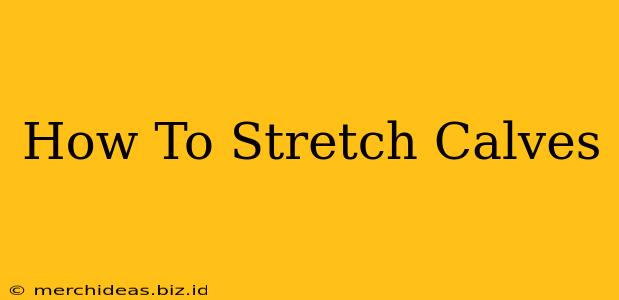Tight calves are a common problem, leading to discomfort, reduced flexibility, and even injury. Whether you're an athlete, a weekend warrior, or simply someone who spends a lot of time on their feet, incorporating regular calf stretches into your routine is crucial. This comprehensive guide will walk you through effective calf stretches, explain their benefits, and offer tips for maximizing your results.
Understanding the Importance of Calf Stretching
Before diving into the stretches themselves, let's understand why calf flexibility is so important:
-
Improved Flexibility and Range of Motion: Tight calves restrict ankle and knee movement, impacting your overall mobility and potentially leading to poor posture. Regular stretching helps improve your range of motion, making everyday activities easier and more comfortable.
-
Injury Prevention: Tight calf muscles increase your risk of strains, sprains, and other lower leg injuries. Stretching helps to lengthen and strengthen the muscles, making them more resilient to injury.
-
Enhanced Athletic Performance: For athletes, flexible calves are essential for optimal performance. They allow for greater power and efficiency in activities like running, jumping, and sprinting.
-
Pain Relief: Many experience calf pain stemming from tightness. Regular stretching can significantly alleviate this pain and improve comfort.
Effective Calf Stretches: A Step-by-Step Guide
Here are some of the most effective calf stretches you can incorporate into your routine. Remember to hold each stretch for at least 30 seconds and repeat 2-3 times on each leg:
1. Standing Calf Stretch
-
How to: Stand facing a wall or sturdy surface, placing your hands on the wall at shoulder height. Step back with one leg, keeping your heel on the ground and your back leg straight. Lean forward until you feel a stretch in your calf muscle.
-
Focus: Keep your heel flat on the ground and your back knee straight for a deeper stretch.
2. Towel Calf Stretch
-
How to: Sit on the floor with your legs extended. Place a towel around the ball of one foot, holding the ends of the towel with your hands. Gently pull on the towel, pulling your toes towards your shin.
-
Focus: Maintain a straight leg for a deeper stretch; you should feel the stretch in your calf.
3. Seated Calf Stretch
-
How to: Sit on the floor with one leg extended straight out. Bend your other leg and place the sole of your foot against your inner thigh. Reach for your toes on your extended leg, pulling gently.
-
Focus: Focus on pulling on your toes, keeping your leg straight.
4. Gastrocnemius Stretch (Standing)
-
How to: Stand facing a wall with your feet hip-width apart. Step one foot back and bend your front knee slightly. Keep your back leg straight and your heel on the ground. Lean into the wall until you feel a stretch in your calf. This targets the gastrocnemius muscle, the larger calf muscle.
-
Focus: Keep your back heel firmly planted for maximum benefit.
5. Soleus Stretch (Knee Bent)
-
How to: Similar to the gastrocnemius stretch, but bend both knees slightly. This targets the soleus muscle, located beneath the gastrocnemius.
-
Focus: A slight bend in your knees will help isolate the soleus.
Tips for Maximizing Your Calf Stretches
-
Consistency is Key: Aim to stretch your calves regularly, ideally daily or several times a week.
-
Listen to Your Body: Don't push yourself too hard. You should feel a stretch, not pain.
-
Warm-up First: Light cardio, like walking or jogging, will prepare your muscles for stretching.
-
Proper Form: Focus on maintaining proper form to avoid injury.
-
Breathe Deeply: Deep breaths help to relax your muscles and improve the stretch.
-
Combine with Other Exercises: Include strength training exercises that target your calf muscles for optimal results.
Conclusion: Flexible Calves for a Healthier You
Incorporating regular calf stretches into your routine is a simple yet effective way to improve your flexibility, prevent injuries, and enhance your overall well-being. By following these stretches and tips, you'll be well on your way to enjoying more comfortable movement and a healthier, more active lifestyle. Remember to consult with a healthcare professional if you experience persistent pain or discomfort.
